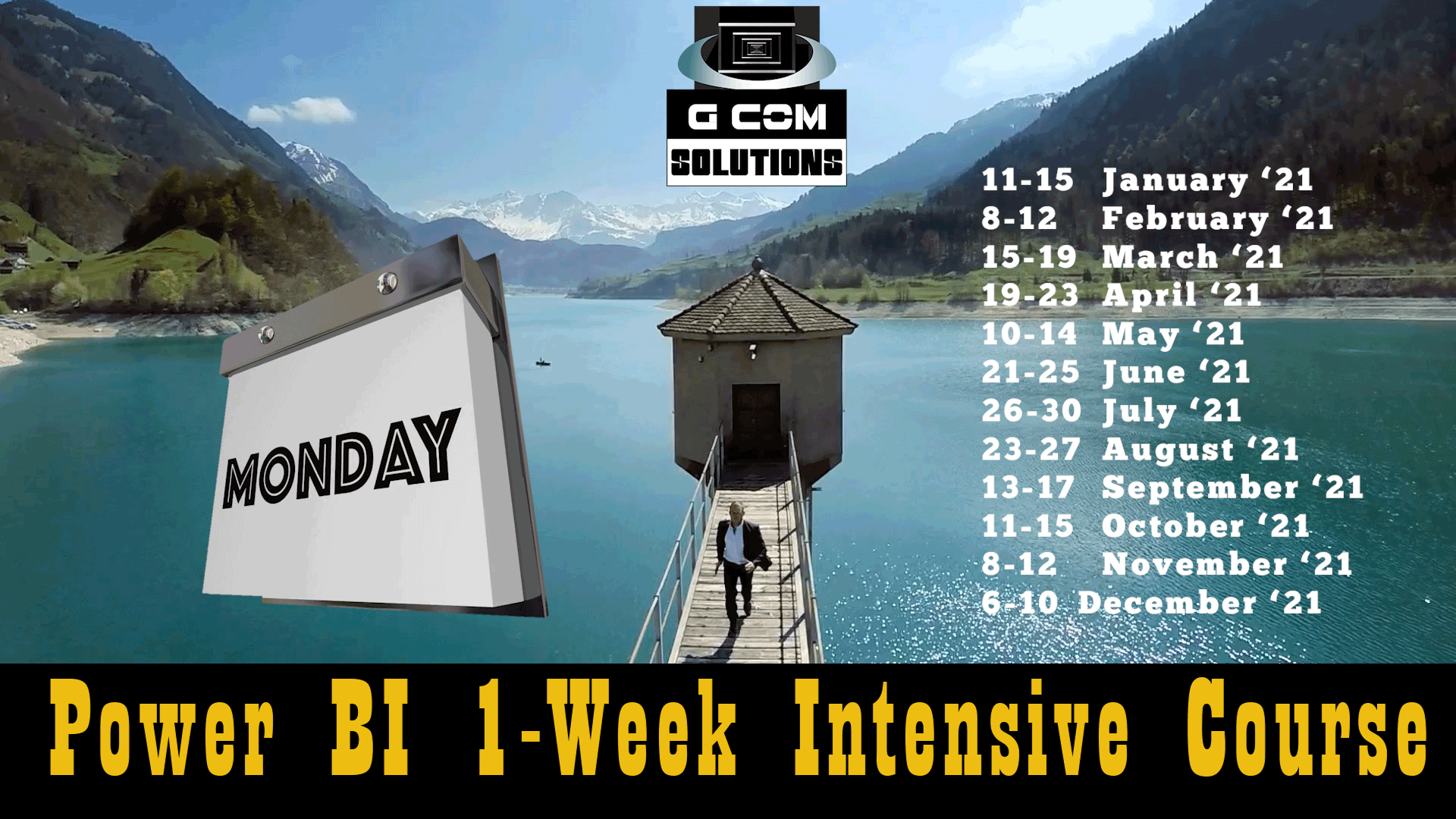Power BI 1 Week Intensive Training Course
-
Power BI 1-Week Intensive Course (Intro, Intermediate & Advanced)
£1,895.00 Select options This product has multiple variants. The options may be chosen on the product page
Our Power BI 1 Week Intensive Training Course offers comprehensive coverage of both basic and advanced features of Microsoft Power BI. This course is designed for users who are new to Power BI, but who intend to use the program extensively in their business workflows.
You should consider taking this course when your company has recently adopted, or are about to adopt Power BI; and you will be playing a pivotal, hands-on role in content-creation and sharing using Power BI Desktop and the Power BI service.
The Power BI 1 Week Intensive Training Course consists of three components: Power BI Introduction, Power BI Intermediate and Power BI Advanced.
We run the Power BI 1 Week Intensive Training Course every month as a public, instructor-led online course. We can also deliver a private online version of this course for up to eight people, allowing your staff to take the training either from the office or at home.
Course Outline
Power BI Introduction
Getting started
The key components of Power BI; What is Power BI Desktop; The Power BI service; Power BI free vs Power BI Pro; Power BI vs Excel add-ins; Dashboards, reports and datasets
Connecting to software services
Understanding content packs for services; Google Analytics content pack; Salesforce content pack; Microsoft Dynamics CRM content pack
Getting data into Power BI
Connecting to data sources in the Power BI service; Connecting to data sources in Power BI Desktop; Importing excel workbooks; Importing Access databases; Connecting to SQL Server
Cleaning up and transforming data
Using the Query Editor; Creating a query; Understanding query steps; Automatically generated steps; Removing query steps; Modifying query steps; Renaming columns; Reordering and removing columns; Changing data types; The close & apply command
Data modelling
Working in data view; Working in relationship view; Auto-detection of table relationships; Creating table relationships manually; Setting cardinality; Cross filter direction
Using DAX
Creating Calculated columns; Creating measures; Understanding row context; Understanding filter context; The SUMX function; The CALCULATE function; The ALL function; The FILTER function; Using time intelligence functions
Creating reports
Working in report view; Creating tables and key metrics; Working with matrixes; Filtering data with slicers
Creating visualizations
Creating column and bar charts; Creating line and area charts; Creating scatter charts; Treemap visualizations; Using charts as slicers; Using maps with geographical data; Using custom visuals in your reports
Publishing content
Publishing Power BI Desktop reports; Printing and exporting dashboards and reports; Creating Groups in the Power BI service; Creating content Packs; Assigning groups to content packs; Sharing dashboards with your organization; Publishing reports to the web; Embedding a report in a web page
Creating Power BI Mobile Content
Optimising visuals for small viewports; Creating a phone version of a dashboard; Creating phone-optimised reports
Consuming and customizing content
Browsing group content; Using content packs; Creating read-only versions; Using Quick Insights in Power BI; Creating dashboards from your reports; Querying with natural language; Creating custom Q & A suggestions
Refreshing content
Setting up a personal gateway; Customizing dataset refresh settings; Scheduling a refresh frequency; Setting up enterprise gateways; Managing enterprise gateways; Adding and removing data sources, Creating live connections to data
Power BI Intermediate
Parameters and Templates
Benefits of parameters and templates; Creating parameters; Parameter value types; Parameterizing data sources; parameterizing filters; Creating a template; Using a template
Power Query Functions
Converting a query to a function; Understanding function syntax; Invoking a function
DAX Time Intelligence
Calendar tables; Power BI Auto Date/Time feature; The TOTALYTD function; Specifying end of fiscal year;Calculating running totals; the SAMEPERIODLASTYEAR function; the PARALLELPERIOD function; Using the DATEADD function for maximum flexibility
What If Parameters
Creating a what-if parameter; Specifying limits; Referencing the parameter measure; Incorporating parameter values in your model
Excel Integration
Analyze in Excel; Installing Power BI Publisher for Excel; Creating pivot table reports from Power BI data sources; The importance of data types; Error – The field that you are moving cannot be placed in that PivotTable area; Pinning Excel content to a Power BI dashboard
Custom visuals
Overview of custom visuals; Chiclet Slicer; Timeline; Advanced Time Slicer; Hierarchy Slicer; Synoptic Panel; Waffle Chart; Percentile Chart; Box and Whisker; Histogram; Bullet Chart; KPI Indicator; GlobeMap; Table Heatmap; WordCloud
Business narration
Planning narratives; Self-running narratives; Interactive narratives; Using the Pulse chart visual; Using the Scroller visual; Using Narratives for Power BI; Using video clips in your visuals
PowerPoint integration
Constructing a narrative in PowerPoint, Using export to PowerPoint, Embedding live reports into a PowerPoint presentation
Power BI Advanced
The Power Query Formula Language
Using The Formula Bar; Using The Advanced Editor; Overview Of The M Language; Exploring M using #shared
Understanding Automatically Generated Code
Excel.Workbook; File.Contents; Table.TransformColumns; Table.TransformColumnTypes; Table.UnpivotColumns; Table.UnpivotOtherColumns
Creating custom functions in M
Defining a function; Defining input parameters; The goes-to operator; Defining the function body; Using optional parameters; Calling functions
Iteration Techniques
Benefit of generating lists; Generating lists of numbers; Generating lists of dates; Generating alphanumeric lists; Using the each function; Applying a function to a list of files
Advanced DAX
Using DAX Studio, Writing complex formulas, Using variables, Calculating moving averages, Calculating running totals, Percentile calculations, Creating advanced time intelligence formulas, Using multiple date tables, Working with non-standard calendars
Working with calculated tables
Creating calculated tables, DAX functions that return tables, The CALCULATETABLE function, The ADDCOLUMNS function, The SUMMARIZE function, SUMMARIZE with ROLLUP, VALUES and DISTINCT functions, The CROSSJOIN function, The TOPN function, The ROW function, Using calculated tables within the data model
Using parameter tables
What is a parameter table, When to use parameter tables, Using the HASONEVALUE function, Using the VALUES function, Creating custom slicers, Creating multiple parameter table solutions
Using ArcGIS Maps for Power BI
Overview of ArgGIS maps integration, Selecting a base map, Creating heat maps, Adding demographic layers, Searching for layers on ArgGIS online
Using R Visualizations and Datasets
Overview of R integration, Configuring R Script Options, Using the R Script editor, Creating correlation plots, Creating predictive plots, Interacting with Power BI visuals
Advanced dashboard tiles
Adding custom links to a dashboard, Using th web content widget, Using the video widget, Real-time streaming dashboard tiles
On-Site Training
Bring expert-led training directly to your team. At G Com Solutions, we provide tailored, on-site training for Power BI, Power Apps, Power Automate, and the Power Platform. Our CPD-accredited courses ensure that every participant receives a formal certificate upon completion, helping track professional development and meet regulatory requirements.
We offer on-site training across England, Scotland, and Wales, delivering a convenient and cost-effective solution for teams of all sizes. All-inclusive pricing with no additional charges for travel or accommodation makes budgeting simple and transparent.
Why Choose On-Site Training?
- Tailored Content: Customized courses to meet your team’s skill levels, business objectives, and industry-specific needs.
- CPD Accreditation: Formal CPD certificates for all participants to support professional development tracking.
- Practical Learning: Hands-on training designed to provide job-ready skills your team can apply immediately.
- Cost Transparency: Flat-rate pricing with no hidden fees for travel or accommodation.
Our pricing structure is based on three simple zones (A, B, and C), covering England, Wales, and Scotland (Glasgow and Edinburgh). Training is available for up to 10 delegates per session. See the pricing table and map below for details.
| Zone | Price (up to 10 delegates) |
|---|---|
| Zone A | £1,795 (plus VAT) per day |
| Zone B | £1,895 (plus VAT) per day |
| Zone C | £1,995 (plus VAT) per day |
 | |

On-site training is the ideal choice for organizations seeking tailored, practical learning experiences delivered directly to their team. Whether you’re looking to develop Power Platform expertise or tackle specific business challenges, our expert trainers will customize the course to meet your needs. To explore how we can help, please fill out the form below or contact us at 0800 998 9248.



